Hydrotherapy in Australia
Complete Guide to Hydrotherapy Benefits, Uses & Recovery
A comprehensive guide for Australian consumers exploring hydrotherapy as a health and rehabilitation option by Movement Rehabilitation.
If you’re dealing with chronic pain, recovering from surgery, or managing a long-term health condition, you’ve likely heard about hydrotherapy as a potential treatment option.
But with conflicting information online, it can be challenging to understand what hydrotherapy actually involves, whether it’s right for your situation, and how to find and access quality services in Australia.
This comprehensive guide outlines the evidence-based, practical information about hydrotherapy. Written from the perspective of physiology professionals who work with hydrotherapy patients daily, we wrote this article to address the most common questions our customers have: What exactly is hydrotherapy? How does it differ from regular swimming? What conditions does it help? How much does it cost? And most importantly, how do you know if it’s right for you?
Whether you’re exploring hydrotherapy for arthritis pain, post-surgical rehabilitation, neurological conditions, or general wellness, this guide provides the authoritative information you need to make informed decisions about your health.
What Is Hydrotherapy?
Hydrotherapy is the therapeutic use of water to treat various health conditions, reduce pain, and improve physical function.
Unlike recreational swimming or water aerobics, hydrotherapy involves specific, targeted exercises performed in specially designed pools under professional guidance.
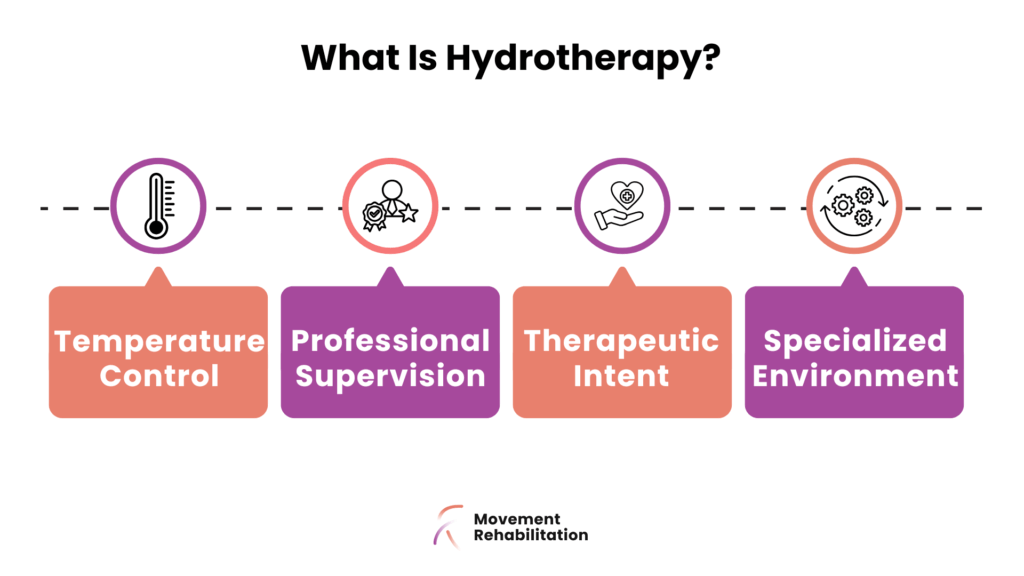
The key distinguishing factors of hydrotherapy include:
- Temperature Control: Hydrotherapy pools are heated to 33-36°C, significantly warmer than standard swimming pools (typically 28°C). This elevated temperature is crucial for therapeutic benefits, as it helps relax muscles, reduce joint stiffness, and improve circulation.
- Professional Supervision: True hydrotherapy is conducted by qualified healthcare professionals, including exercise physiologists, physiotherapists, or specially trained aquatic therapy specialists. These professionals design individualised programs based on your specific condition, goals, and limitations.
- Therapeutic Intent: Every movement and exercise in hydrotherapy has a specific therapeutic purpose, whether it's improving range of motion, building strength, reducing pain, or enhancing balance and coordination.
- Specialised Environment: Hydrotherapy facilities are designed with accessibility in mind, featuring ramps, hoists, handrails, and adjustable depth areas to accommodate people with various mobility levels and physical limitations.
- Aquatic Therapy: The most common alternative term, particularly used in clinical settings
- Aquatic Rehabilitation: Emphasises the rehabilitative aspect of the treatment
- Pool Therapy: A more casual term often used by patients
- Balneotherapy: Specifically refers to treatment using mineral-rich spa waters
- Water Therapy: A general term that encompasses various water-based treatments
Hydrotherapy vs Swimming
How Hydrotherapy Differs from Swimming
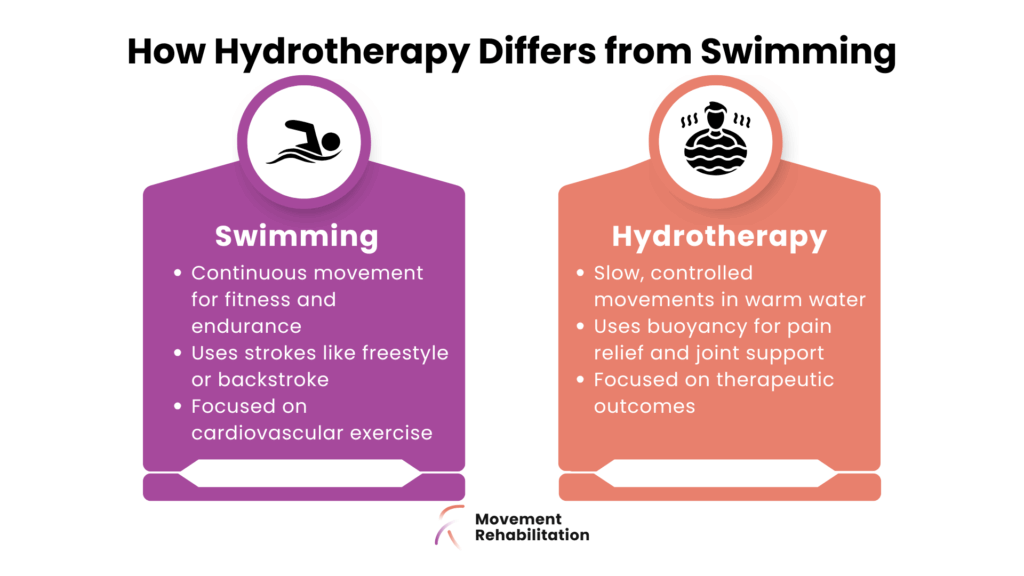
Here’s how they differ:
Swimming is primarily a cardiovascular exercise that focuses on technique, endurance, and fitness. It typically involves continuous movement through water using established strokes like freestyle, backstroke, or breaststroke.
Hydrotherapy, by contrast, uses water’s unique properties—buoyancy, hydrostatic pressure, and thermal effects—to create specific therapeutic outcomes. Movements are often slow, controlled, and may involve standing, walking, or performing exercises while stationary in the water.
For example, a person with knee arthritis might perform gentle leg lifts and range-of-motion exercises in chest-deep water, taking advantage of buoyancy to reduce joint stress while the warm water helps manage pain. This targeted approach addresses specific therapeutic goals that swimming alone cannot achieve.
The Science Behind Hydrotherapy
The Three Pillars of Hydrotherapy
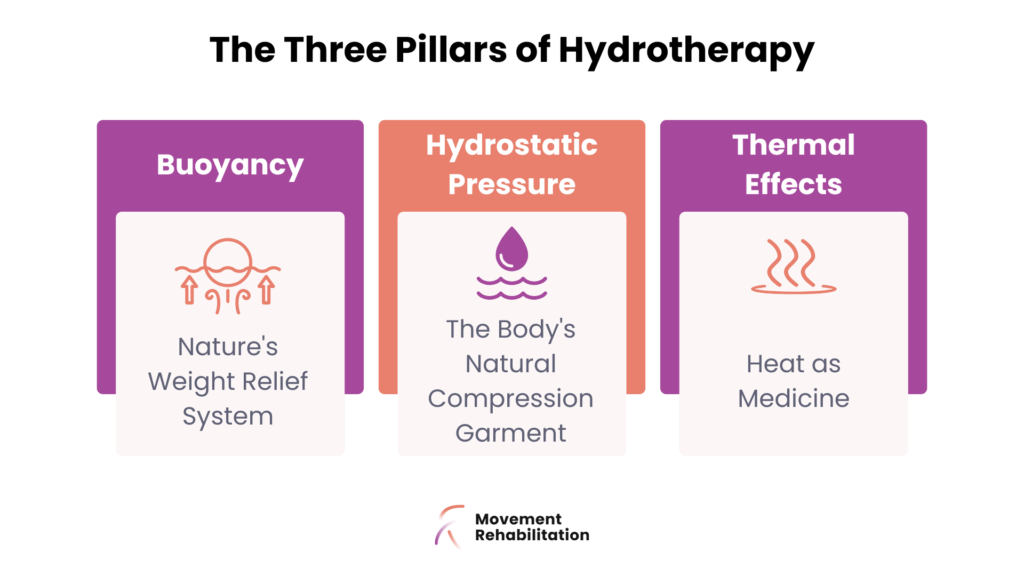
- Buoyancy: Nature’s Weight Relief System
When you enter water, Archimedes’ principle immediately goes to work. Your body experiences buoyancy equal to the weight of water displaced, effectively reducing the gravitational load on your joints and muscles. This isn’t just theoretical—the effects are dramatic and measurable:
- Standing in waist-deep water reduces body weight by approximately 50%
- Chest-deep water reduces body weight by about 75%
- Neck-deep immersion can reduce weight-bearing by up to 90%
For someone with knee arthritis weighing 80kg, exercising in chest-deep water means their knees only support about 20kg of body weight. This dramatic reduction allows movement that might be impossible or extremely painful on land, enabling therapeutic exercise that promotes healing without exacerbating symptoms.
- Hydrostatic Pressure: The Body’s Natural Compression Garment
Water exerts pressure on all submerged surfaces of the body, creating a natural compression effect that increases with depth. At a depth of just one meter, this pressure is significant enough to produce measurable physiological changes:
- Enhanced Circulation: Hydrostatic pressure compresses blood vessels, improving venous return and reducing swelling in extremities. This is particularly beneficial for people with lymphedema, chronic venous insufficiency, or post-surgical swelling.
- Respiratory Benefits: The pressure on the chest wall requires respiratory muscles to work harder, potentially improving breathing efficiency and lung function over time.
- Proprioceptive Enhancement: The constant, even pressure provides sensory feedback that can improve body awareness and balance, particularly valuable for people with neurological conditions.
- Thermal Effects: Heat as Medicine
The elevated temperature of hydrotherapy pools (33-36°C) isn’t just for comfort—it’s a crucial therapeutic tool with well-documented physiological effects:
- Muscle Relaxation: Heat increases tissue elasticity and reduces muscle tension, allowing for greater range of motion and reduced pain during exercise.
- Pain Reduction: Warm water activates the gate control theory of pain, where non-painful sensory input (heat and pressure) can override pain signals to the brain.
- Improved Circulation: Heat causes vasodilation, increasing blood flow to muscles and joints, which enhances nutrient delivery and waste removal.
Endorphin Release: The combination of warmth and gentle exercise stimulates the release of endorphins, the body’s natural pain-relieving chemicals.
Neurological and Psychological Benefits
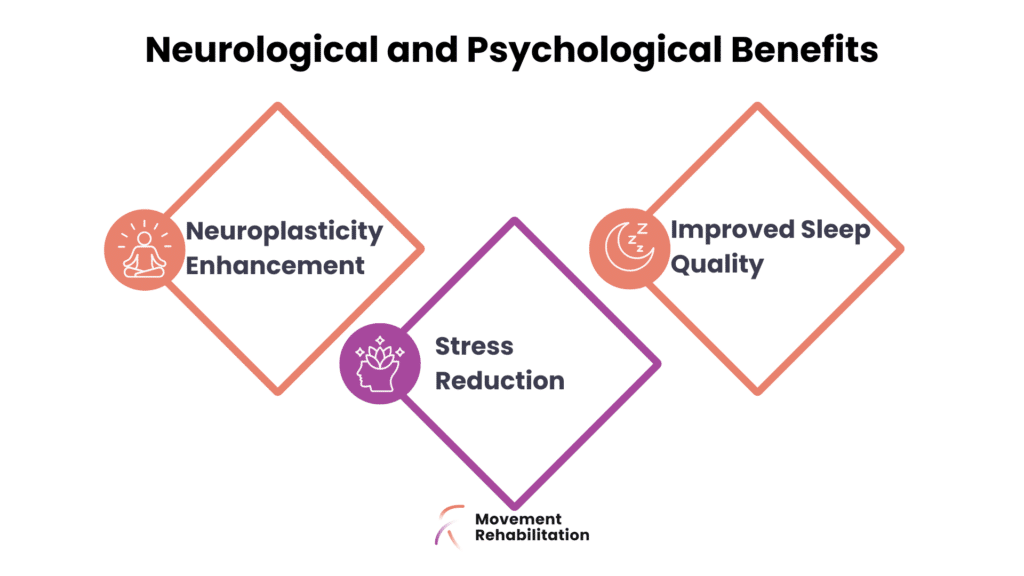
Neuroplasticity Enhancement: The novel sensory environment of water—with its unique combination of pressure, temperature, and movement resistance—can stimulate neuroplasticity, the brain’s ability to form new neural connections. This is particularly relevant for stroke recovery and other neurological rehabilitation.
Stress Reduction: Multiple studies have documented hydrotherapy’s ability to reduce cortisol levels and activate the parasympathetic nervous system, promoting relaxation and reducing anxiety [12]. This stress reduction isn’t just psychological comfort—it has measurable effects on inflammation, immune function, and pain perception.
Improved Sleep Quality: Regular hydrotherapy sessions have been associated with improved sleep patterns, likely due to the combination of physical exertion, stress reduction, and the natural temperature regulation that occurs after leaving warm water.
The Resistance Training Effect
Water provides variable resistance that automatically adjusts to the force applied—the harder you push, the greater the resistance. This unique property allows for:
- Safe Strength Training: Unlike weights, water resistance cannot cause sudden, jarring movements that might injure compromised joints or muscles.
- 360-Degree Resistance: Every movement in water encounters resistance, providing comprehensive muscle activation that’s difficult to achieve with traditional exercise equipment.
Accommodating Resistance: As fatigue sets in and movement speed decreases, water resistance automatically reduces, allowing for continued exercise without the risk of overexertion.
Evidence from Recent Research
Recent meta-analyses have provided compelling evidence for hydrotherapy’s effectiveness. A 2024 systematic review of randomised controlled trials found that hydrotherapy significantly reduced pain and improved functional status in patients with knee osteoarthritis, with benefits evident as early as one week and continuing through eight weeks of treatment.
The study analysed data from multiple high-quality trials and found:
- Significant pain reduction at 1 week (effect size: -0.429)
- Continued improvement at 4 weeks (effect size: -0.308)
- Sustained benefits at 8 weeks (effect size: -0.724)
- Improved functional scores on standardised assessments
- No increase in adverse events compared to control groups
These findings represent the gold standard of medical evidence and demonstrate that hydrotherapy’s benefits are not just anecdotal—they’re scientifically validated and clinically significant.
While the scientific principles of hydrotherapy are universal, individual responses can vary significantly based on factors including:
- Condition severity and duration
- Overall fitness level
- Previous water experience
- Psychological factors and expectations
- Concurrent treatments and medications
This variation underscores the importance of professional assessment and individualised program design, rather than assuming a one-size-fits-all approach to hydrotherapy treatment.
Proven Benefits: What Research Shows
When considering any therapeutic intervention, it’s essential to understand what benefits are supported by scientific evidence versus what might be marketing hype.
Hydrotherapy has been extensively studied, and the research reveals both benefits and some limitations to understand.
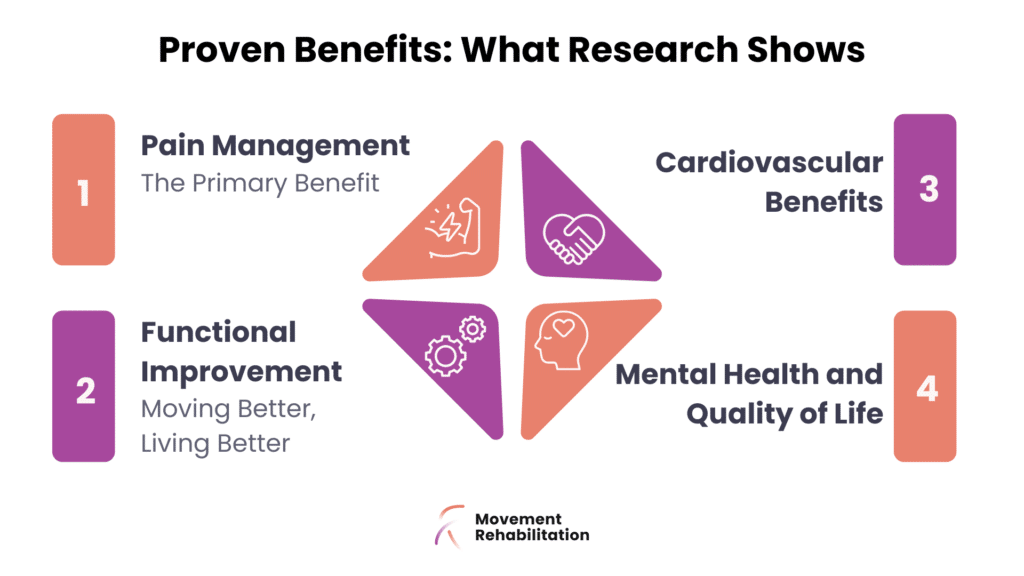
#1. Pain Management
#1. Pain Management: The Primary Benefit
Immediate Pain Relief: One of hydrotherapy’s most consistent and well-documented benefits is pain reduction. Multiple studies have demonstrated that even a single hydrotherapy session can provide immediate pain relief that lasts for hours after leaving the pool.
The pain relief mechanisms are multifaceted:
- Gate Control Theory: The sensory input from warm water and hydrostatic pressure can override pain signals
- Muscle Relaxation: Heat reduces muscle tension and spasm
- Endorphin Release: Exercise in warm water stimulates natural pain-relieving chemicals
- Reduced Inflammation: Improved circulation helps remove inflammatory mediators
Sustained Pain Reduction: More importantly for chronic conditions, regular hydrotherapy sessions can lead to sustained pain reduction. A recent meta-analysis found that patients with knee osteoarthritis experienced progressive pain reduction over 8 weeks of treatment, with benefits maintained for weeks after treatment ended.
#2. Functional Improvement
#2. Functional Improvement: Moving Better, Living Better
Range of Motion Enhancement: The combination of buoyancy and heat allows people to move joints through ranges that might be impossible on land. Studies consistently show that hydrotherapy can improve joint flexibility more effectively than land-based exercise alone, particularly for conditions like arthritis and post-surgical rehabilitation.
Strength Gains: While water exercise might seem “easier” than land-based training, research demonstrates that properly designed hydrotherapy programs can produce significant strength improvements. The variable resistance of water, combined with the ability to exercise pain-free, often allows for more consistent training than traditional methods.
Balance and Coordination: The unstable environment of water challenges proprioceptive systems, leading to improved balance and coordination. This is particularly valuable for older adults and people with neurological conditions, where fall prevention is a critical concern.
#3. Cardiovascular Benefits
Heart Health: Hydrotherapy provides excellent cardiovascular exercise with reduced joint stress. The hydrostatic pressure assists venous return, potentially making water exercise more efficient for cardiovascular conditioning than equivalent land-based activities.
Blood Pressure Reduction: Multiple studies have documented blood pressure reductions following hydrotherapy sessions, with some research suggesting that regular aquatic exercise can contribute to long-term blood pressure management.
#4. Mental Health and Quality of Life
Mood Enhancement: The combination of exercise, warm water, and often social interaction in group sessions contributes to significant mood improvements. Studies have documented reductions in depression and anxiety scores following hydrotherapy programs.
Sleep Quality: Many patients report improved sleep following hydrotherapy sessions. This likely results from the combination of physical exertion, stress reduction, and the natural temperature regulation that occurs after leaving warm water.
Social Connection: Group hydrotherapy sessions provide social interaction that can be particularly valuable for people whose conditions have led to social isolation. This social component often contributes significantly to overall treatment satisfaction and adherence.
Other Condition-Specific Benefits
Arthritis: For arthritis sufferers, hydrotherapy offers a unique combination of pain relief, improved mobility, and the ability to exercise without exacerbating joint damage. Research consistently shows improvements in pain, stiffness, and functional capacity.
Fibromyalgia: People with fibromyalgia often find that hydrotherapy is one of the few forms of exercise they can tolerate. Studies show reductions in tender point pain, improved sleep, and enhanced quality of life.
Neurological Conditions: For conditions like multiple sclerosis, Parkinson’s disease, and stroke recovery, hydrotherapy can improve mobility, balance, and coordination while providing a safe exercise environment.
Post-Surgical Rehabilitation: Hydrotherapy allows for earlier mobilisation after surgery, potentially reducing recovery time and improving outcomes. The buoyancy support enables movement that might be too painful or risky on land.
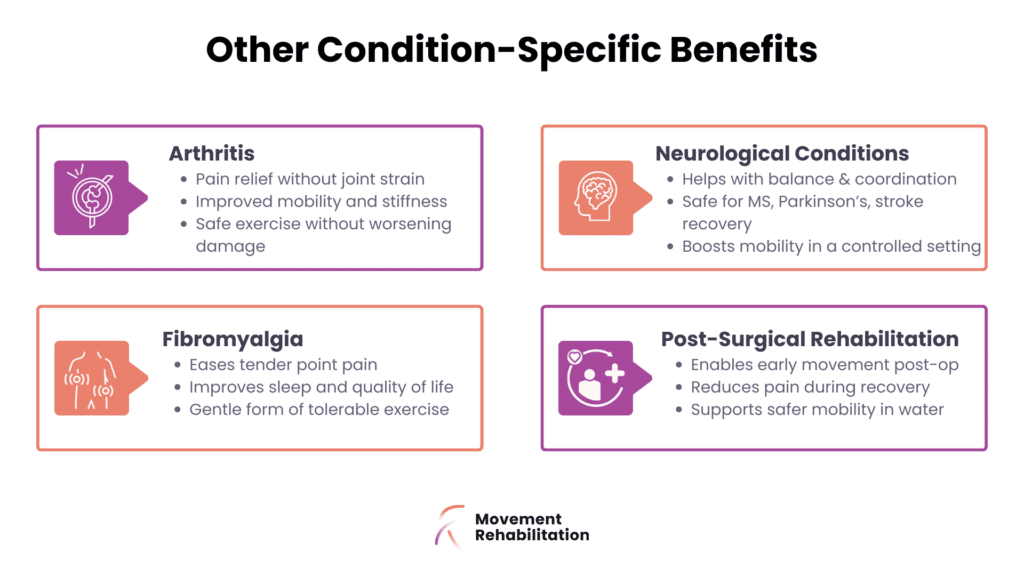
Setting Realistic Expectations
What Hydrotherapy Cannot Do: Setting Realistic Expectations
While hydrotherapy offers significant benefits, it’s crucial to understand its limitations:
Not a Cure: Hydrotherapy manages symptoms and improves function but doesn’t cure underlying conditions. For chronic conditions like arthritis, it’s a management tool, not a cure.
Temporary Effects: Many benefits, particularly pain relief, are temporary. Regular sessions are typically needed to maintain improvements.
Not Suitable for Everyone: Certain medical conditions and personal factors can make hydrotherapy inappropriate or less effective.
Requires Consistency: Like any exercise program, hydrotherapy requires regular participation to achieve and maintain benefits.
It’s important to note that while hydrotherapy research is extensive, the quality varies. The strongest evidence exists for:
- Pain reduction in arthritis and musculoskeletal conditions
- Functional improvement in post-surgical rehabilitation
- Balance and mobility enhancement in neurological conditions
Areas where evidence is emerging but less definitive include:
- Optimal treatment frequency and duration
- Long-term outcomes after treatment cessation
- Comparative effectiveness of different hydrotherapy approaches
This evidence profile suggests that while hydrotherapy is a well-supported intervention, ongoing research continues to refine our understanding of how to optimise its use for different conditions and populations.
What to Expect: Your First Hydrotherapy Experience
Understanding what happens during hydrotherapy sessions helps reduce anxiety and ensures you’re properly prepared.
Whether you’re attending your first individual session or joining a group class, knowing what to expect allows you to focus on the therapeutic benefits rather than worrying about the unknown.
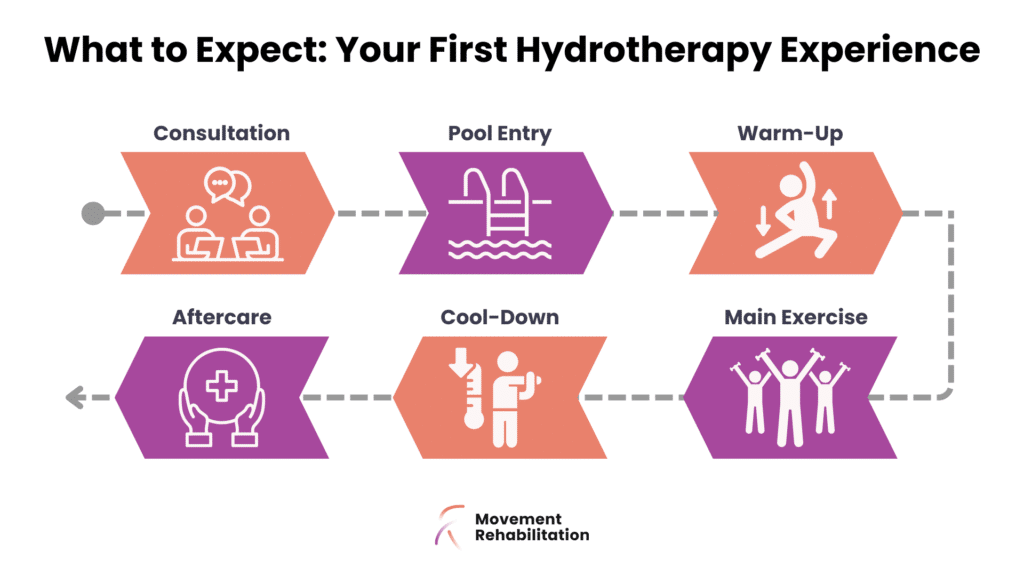
Before Your First Session
Most hydrotherapy providers begin with a comprehensive consultation, typically lasting 45-60 minutes.
This crucial first step involves:
Health History Review: Your exercise physiologist or physiotherapist will discuss:
- Your current condition and symptoms
- Previous injuries or surgeries
- Medications that might affect exercise
- Other treatments you’re receiving
- Your goals and expectations for hydrotherapy
Physical Assessment: This may include:
- Range of motion testing
- Strength evaluation
- Balance and coordination assessment
- Pain level documentation
- Functional movement screening
Water Comfort Evaluation: Your practitioner will assess:
- Your swimming ability (or lack thereof)
- Comfort level in water
- Any fears or anxieties about water
- Previous water exercise experience
Program Design: Based on the assessment, your practitioner will:
- Explain how hydrotherapy can help your specific condition
- Outline a preliminary treatment plan
- Discuss frequency and duration of sessions
- Set realistic short-term and long-term goals
In Australia, hydrotherapy is formally recognised within the healthcare system and typically delivered by Accredited Exercise Physiologists or physiotherapists. These professionals follow national practice standards, ensuring your treatment is safe and evidence-based.
This also means many programs are eligible for support through Medicare, private health insurance, or the NDIS, making hydrotherapy more accessible across different patient groups.
Long-Term Outcomes: What to Expect
Short-Term (1-4 weeks): Most people experience some pain relief and improved mobility within the first few sessions. Mood improvements are often noticed quickly.
Medium-Term (1-3 months): With consistent participation, expect more substantial improvements in strength, endurance, and functional capacity. Sleep and mood benefits typically become more pronounced.
Long-Term (3+ months): Sustained improvements in overall quality of life, reduced medication dependence, and better management of chronic conditions. However, benefits typically require ongoing participation to maintain.
What to Bring
Essentials:
- Swimwear: A comfortable, well-fitting swimsuit that allows for easy movement
- Towel: Most facilities provide towels, but bringing your own ensures comfort
- Water Bottle: Staying hydrated is important, even in water
- Medications: Any rescue medications you might need (inhalers, pain relief, etc.)
- Footwear: Non-slip shoes for walking on wet surfaces
Optional items:
- Goggles: If you’re comfortable with your head underwater
- Water Shoes: For extra grip on pool surfaces
- Robe or Cover-up: For comfort when moving between areas
- Hair Ties: To keep hair out of your face during exercises
What to leave at home:
- Jewelry: Remove all jewelry to prevent loss or injury
- Lotions or Oils: These can affect pool water quality
- Electronic Devices: Unless specifically waterproof and approved
Facility Tour and Orientation
Pool Area Familiarisation: Your first visit typically includes a tour of the facility:
- Entry and Exit Points: Learning the safest ways to get in and out of the pool
- Depth Zones: Understanding where you can stand comfortably
- Safety Equipment: Location of emergency equipment and procedures
- Changing Facilities: Accessible changing rooms and shower areas
- Temperature Controls: Understanding how the pool temperature is maintained
Safety Briefing: Essential safety information includes:
- Emergency Procedures: What to do if you feel unwell or need help
- Communication Signals: How to get your therapist’s attention
- Pool Rules: Specific guidelines for the therapeutic environment
- Equipment Use: Proper handling of any assistive devices
Conclusion
Hydrotherapy is a proven way to manage pain, improve movement, and enhance quality of life for people with a wide range of conditions.
Research shows strong benefits—particularly for arthritis, post-surgical recovery, and chronic pain management—along with improvements in sleep, mood, and overall wellbeing.
In Australia, access is growing through Medicare, private health insurance, and the NDIS, making it easier for people to find quality care. Success with hydrotherapy comes with consistency, patience, and support from qualified professionals.
For anyone considering it, Movement Rehabilitation offers hydrotherapy demonstrations and exercise programming as part of our treatment plans. The water is waiting—and so is the potential for a healthier, more active future.